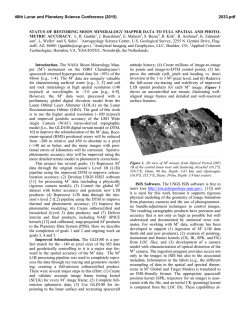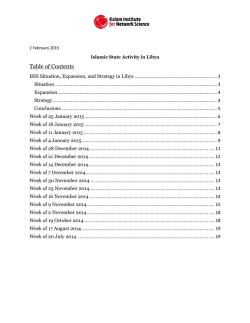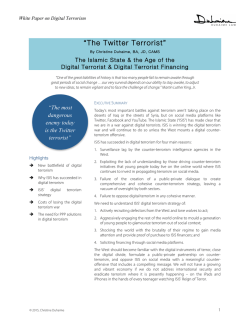
2782
46th Lunar and Planetary Science Conference (2015) 2782.pdf THE PRESENT AND FUTURE OF PATTERN MATCHING IN THE INTEGRATED SOFTWARE FOR IMAGERS AND SPECTROMETERS (ISIS). P. A. Garcia1, L. Keszthelyi1, T. Becker1, K. Becker1, S. Sides1, 1 U. S. Geological Survey, 2255 N. Gemini Drive, Flagstaff, Arizona 86001 ([email protected]). Introduction: The Integrated Software for Imagers and Spectrometers (ISIS) [1] was developed by the USGS Astrogeology Science Center to cartographically process images collected by current and past NASA and international planetary missions. In this abstract we discuss the pattern matching (i.e., identifying the same location on two or more images) capabilities currently available in ISIS, as well as research to expand them. The most common use for pattern matching is to “tie” or “register” multiple images to each other. ISIS has multiple applications used in the pattern matching process – including applications to identify positions on images with a high potential for accurate matching, and searching for similar patterns within images. Pointreg is used to register multiple overlapping images together to create a tie-point network [2] that is used by photogrammetric bundle adjustment software (jigsaw), and coreg is used to tie two images to each other. Current Pattern Matching in ISIS: The algorithms currently utilized by ISIS all rely on “areabased matching” (ABM) [3]. In the simplest terms, ABM attempts to find a sub-area of an image (the “pattern chip”) inside a sub-area of another image (the “search chip”). The pattern chip is systematically “walked” through the search chip to find the best registration using one of three algorithms: “maximum correlation,” “minimum difference,” and “Gruen” [4]. Each algorithm provides the whole- or sub-pixel location of the highest value of the “goodness of fit” (GOF) between the pattern and search chips, assuming the fit is better than a user-defined tolerance value. Additionally, some basic image processing can be applied to the pattern and search chips to improve the operation of the matching algorithms. There are a large number of parameters the user must select to successfully use any of the pattern matching applications in ISIS (Table 1). The values for these parameters are specified using a “definition file” which is in parameter value language (PVL) format. In order to have these applications return useful results, it is almost always necessary to change parameter values from the defaults supplied in ISIS. The primary objective of this presentation is to assist in selecting better parameter values. In this abstract, we focus on the most widely used matching algorithm, “maximum correlation.” Maximum Correlation Algorithm. This matching algorithm computes a correlation coefficient, R, between the pattern chip and each sub-region of the search chip. No correlation returns R=0, a perfect correlation R=1, and a perfect anti-correlation R=-1. ISIS uses the absolute value of R as the GOF, so anticorrelation is also considered a good fit. A simple polynomial is fit to the cluster of highest GOF pixels to compute the sub-pixel location of the peak in GOF. The user selects the minimum acceptable value for the GOF via the TOLERANCE parameter. If no location in the search chip returns a value above this value, the matching algorithm “fails” (does not return a match). Table 1. List of parameters and valid range of values for the pattern matching definition file. defffile Keyword Group(s) Algorithms Type Values Default {MaximumCorrelation, No default. Value MinimumDifference, required. Gruen} No default. Value [0.0, infinity) required. {NearestNeighborType, BiLinearType, CubicConvolutionType CubicConvolutionType} [1, infinity) 1 {True, False} TRUE {None, Sobel} None No default. Value [1, infinity) required. No default. Value [1, infinity) required. Name Algorithm All String Tolerance Algorithm All Real ChipInterpolator Algorithm All String ReductionFactor SubPixelAccuracy Gradient Algorithm Algorithm Algorithm PatternChip, SearchChip PatternChip, SearchChip PatternChip, SearchChip PatternChip, SearchChip PatternChip PatternChip SearchChip SurfaceModel SurfaceModel Algorithm All All All Integer Boolean String All Integer All Integer All Real (-infinity, infinity) Isis::ValidMinimum All Real (-infinity, infinity) Isis::ValidMaximum All All All All All Gruen Real Real Real Real Integer Integer (0.0, infinity) (0.0, 100.0] (0.0, 100.0] (0.0, infinity) [3, infinity) odd (-infinity, infinity) 1 50 50 1.5 5 25 AffineTranslationTolerance Algorithm Gruen Real (-infinity, infinity) 0.1 AffineScaleTolerance AffineShearTolerance AffineTolerance SpiceTolerance RadioShiftTolerance Algorithm Algorithm Algorithm Algorithm Algorithm Gruen Gruen Gruen Gruen Gruen Real Real Real Real Real (-infinity, infinity) (-infinity, infinity) (-infinity, infinity) (-infinity, infinity) (-infinity, infinity) 0.5 AffineScaleTolerance DBL_MAX DBL_MAX DBL_MAX RadioGainMinTolerance Algorithm Gruen Real (-infinity, infinity) -DBL_MAX RadioGainMaxTolerance Algorithm Gruen Real (-infinity, infinity) DBL_MAX FitChipScale DefaultRadioGain DefaultRadioShift Algorithm Algorithm Algorithm Gruen Gruen Gruen Real Real Real (-infinity, infinity) (-infinity, infinity) (-infinity, infinity) Samples Lines ValidMinimum ValidMaximum MinimumZScore ValidPercent SubchipValidPercent DistanceTolerance WindowSize MaximumIterations 0.1 0 0 Selecting a value for TOLERANCE. A perfect correlation is impossible between two real images. The causes include variations in (a) illumination geometry (including shadows), (b) spatial resolution, (c) noise, (d) spectral response, or (e) the actual surface and atmosphere. The fewer variations, the closer the TOLERANCE value can be set to 1, but there is no substitute for trial and error to find an optimal value. When the algorithm fails to identify valid matches, the 46th Lunar and Planetary Science Conference (2015) user may increase the number of valid matches by lowering the TOLERANCE value being used. This, however, can also lead to more false matches or “false positives.” This is one of the most insidious failure modes of pattern matching in ISIS, because there is no way to distinguish true and false matches except discovering poor results in later processing steps. Even a limited number of bad points can seriously degrade the final product and it is time intensive to identify and remove these points, so it is generally preferable to set a higher TOLERANCE and to minimize false positives. Sizing the Pattern and Search Chips. In general, larger pattern chips should provide more robust matches with fewer false positives since there are more data to be correlated. Likewise, a larger search chip should compensate for errors in the initial estimate of the relative locations of the images. However the computation required rises rapidly with chip size so keeping chip sizes as small as possible is often essential. Table 2 provides some practical starting points for some commonly used data sets. It must be emphasized that these are only suggested starting points for finding useful values – there are many cases where different values are needed to match images in these data sets. The most important component of successful pattern matching in ISIS is to know your data well. Knowing the resolution ranges, overlap patterns, and differences in viewing geometry and illumination of your data will help you achieve successful matching results. Equally important is an understanding of the information content within the images. Bland areas require large pattern chips to capture some unique surface patterns. Areas with large numbers of similar features (e.g., secondary impact craters) similarly require large pattern chips. In many cases the largest uncertainty in the relative position of the images is related to timing, resulting in much larger down-track errors than acrosstrack. If there is too much change on the surface (e.g., images with and without frost) matching may be simply impossible with these algorithms. Table 2. Suggested pattern and search chip sizes found useful in the past for some widely used instruments, given as samples x lines. Mission/DataSet MESSENGER MDIS Cassini ISS Viking Orbiter Odyssey THEMIS IR MRO HiRISE MRO CTX LRO LROC NAC Pattern Chip Size 31 x 31 51 x 51 101 x 151 71 X 151 51 x 151 151 x 151 151 x 201 Search Chip Size 101 x 101 201 x 201 651 x 651 131 x 231 151 x 251 451 x 451 501 x 1001 2782.pdf Some Other Parameters. CHIPINTERPOLATOR allows a user to select an interpolation algorithm to be used if the pattern chip is being “warped” to match the geometry of the search chip. Since the automatic registration process can be time intensive, the REDUCTIONFACTOR allows a user to reduce the search and pattern chips by the factor supplied. Increasing the REDUCTIONFACTOR speeds up computation, but also reduces the reliability of the pattern matching results. To increase the chances of successful registration, a GRADIENT filter can be applied to the search and pattern chips to highlight the edges in the chips. The use of a gradient filter can be useful in cases where images have differing illumination conditions. Users can restrict pixel values in both the search and pattern chips by using the VALIDMINIMUM and VALIDMAXIMUM keywords. MINIMUMZSCORE is used to help determine if a pattern chip contains enough variation for successful pattern matching. Larger values will identify pattern chips with more variation in pixel values. Future Improvements to Pattern Matching in ISIS: The primary focus is on adding feature-based matching (FBM) [3] capability to ISIS. This is a departure from the area-based matching (ABM) used in current ISIS applications. In feature-based matching (FBM) algorithms the matching primitive is a feature – points, lines, circles, regions or global features called structures. FBM detects distinct and robust objects from images based upon similarity of features. FBM uses significantly less pixels for feature computations than ABM and is less sensitive to noise. Summary: The ability to correctly identify the same location across multiple images is an essential prerequisite for precision cartography. The ISIS software currently provides tools to match images but the burden is on the user to discover (mostly via trial and error) the values for many of the parameters used by the software. We present some of our experience to assist this research effort. We are also working to implement more robust matching algorithms into ISIS over the next few years. Acknowledgements: This work is funded by the NASA Planetary Geology and Geophysics Program References: [1] Keszthelyi, L., et al., 45th Lunar and Planetary Science Conference, 1686.pdf, 2014., [2] Edmundson, K. et al., this volume., [3] Babbar, G., et al. International Journal of Information Technology and Knowledge Management 2.2 : 337-339, 2010., [4] Gruen, A. W., South African Journal of Remote Sensing, Photogrammetry, and Cartography, vol. 14, no. 3, pp 175-187, 1985.
© Copyright 2025




